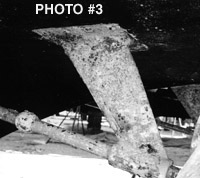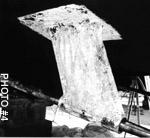Troubleshooting Problems Involving
Engine/Shaft Alignment
by David H. Pascoe, Marine Surveyor
| Page 1 | Page 2 | Page 3 |
Dial Indicating Shafts
Recently a number of articles have appeared
in boating publications about dial indicating shafts while in the boat.
I'll explain why this should never be done. As noted above, boat hulls can
and do change shape over time. Further, the shape of the hull changes when
hauled versus afloat. The changing shape of the hull is likely to
cause the shaft to bend. Now, you may look at a 1.5" stainless shaft and
think that it's cannot be easily bent. In fact, if you suspend it on its
ends, even gravity will bend it considerably. Gravity will bend a 15'
shaft a lot.
Finally, when you rotate the shaft by pulling on the propeller, you're
moving the shaft against the rubber bearing, further throwing your dial
indicator readings off. As any trained machinist will tell you, there's
only one way to dial a shaft and that is on a calibrated roller bed. One
simply cannot dial a rotating object without a reference base and expect
accurate results. And a shaft in a boat doesn't provide such a reference.
Only after all the above checks have been made and proven that all else is
in order, should one then proceed to use the feeler gauges on the
coupling. The problem with using feeler gauges is that this measurement
can give a false indication that all is well. Particularly smaller shafts
can be out of alignment at one end and yet still give a favorable reading
at the coupling end. This is because shafts with multiple bearings can
bend it into a favorable position while overall it is still badly out of
alignment.
Weak Struts
This is a very common problem on small to midsize
boats. If you want to understand just how important strong struts are,
just take a look at the huge struts used on larger Bertrams, Hatteras or
Viking yachts. They don't spend all that money on massive struts for no
reason. When there are hundreds of thousands of dollars at stake in
machinery, the drive support system must be strong.
A further fact to consider is that the smaller and less the value of the
boat is, the less the amount real engineering has gone into its design.
The drive system is one area that is often shortchanged.
Take a close look at the strut arm length to strut base ratio. Or, in
other words, the ratio of the base footprint to the strut length. Also
look at the strut width and cross-sectional thickness. In photograph #3,
notice how long the strut arm is and how narrow the width is. The arm to
width ratio is over 3:1 while the length to base ratio is more that 2:1.
The extreme amount of leverage that the arm applies to the base means that
it can't possibly hold the shaft steady. It will deflect and allow the
shaft and propeller to oscillate.

Photo #3

Photo #4
The strut in photo #4 carries the same size shaft and prop as in #3, both of which are in a 40' boat. But the #4 is double the thickness in both width and cross-sectional area, with a substantially wider base. There is no doubt that this strut will hold the shaft steady. Also notice that the length of the strut bore is double the length of that in photo #3.
This strut will hold the shaft very steady, and because of this, correct
engine/shaft alignment is much more critical. If it's not correctly
aligned, something will have to give, and whatever that is is likely to be
expensive. The same holds true for shafts with double struts. In fact, a
double set of struts will hold a shaft in even closer tolerance. As a
general rule, shafts under 1.5" tend to be self-centering because they
will bend to some small degree. But shafts larger than this do not take
well to bending. They will not bend but work to tear the system apart if
not correctly aligned.
Another general rule is that the larger the shaft diameter, and the more
bearings it has, the more critical are the engine mounts. Unless the
mounts are holding in the engine in place and not permitting any movement,
there's no point in trying to achieve proper alignment of anything. If the
engine moves, no other part of the system will stay in alignment either.
Still another source of engine mount, strut bearing, vibration and
shafting problems results from engines that are mounted on weak stringers,
or on a hull bottom that is flexing. There are literally thousands of
boats that have this problem. During the course of sea trials I frequently
encounter engines that are shuddering and bouncing around to such a degree
that the entire drive system is being damaged, from engine mounts all the
way back to the strut bearings.
Engines mounted on weak stringers frequently results in transmission
failures. This is because the worst part of the misalignment is being
absorbed by the transmission coupling and output shaft bearings. The
problem is usually blamed on the transmission when the source of the
problem is really the hull itself. For boats that have had a history of
transmission failures, this is something that should be checked first,
before blaming the machinery or faulty repairs.
Only after checking all of the above points and making sure that all is in
order should the transmission to shaft coupling alignment be checked and
realigned.
| Page 1 | Page 2 | Page 3 |
First posted on April 19, 1997 at David Pascoe's
site www.yachtsurvey.com.
Page design changed for this site.
Power Boat Books
 Mid Size Power Boats
Mid Size Power Boats A Guide for Discriminating Buyers
Focuses exclusively cruiser class generally 30-55 feet
With discussions on the pros and cons of each type: Expresses, trawlers, motor yachts, multi purpose types, sportfishermen and sedan cruisers.
Selecting and Evaluating New and Used Boats
Dedicated for offshore outboard boats
A hard and realistic look at the marine market place and delves into issues of boat quality and durability that most other marine writers are unwilling to touch.
2nd Edition
The Art of Pre-Purchase Survey The very first of its kind, this book provides the essentials that every novice needs to know, as well as a wealth of esoteric details.
Pleasure crafts investigations to court testimony The first and only book of its kind on the subject of investigating pleasure craft casualties and other issues.






